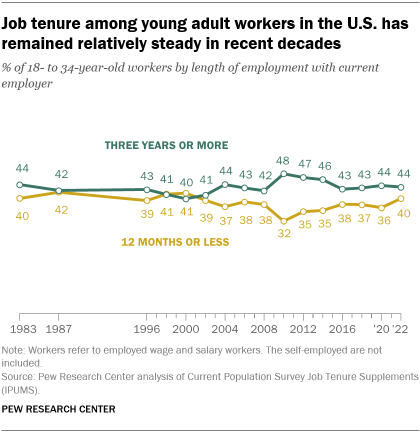Today’s young adults have been on the job with their current employer for about as long as young adults over the past four decades, according to a Pew Research Center analysis of the U.S. government’s most recent job tenure data. Among 18- to 34-year-old workers in the United States, 44% reported in January 2022 that they had been with their current employer for three years or more.

The share of young employees who have been with their employer for three years or more has remained relatively steady over time. But it is down somewhat from the share during the aftermath of the Great Recession (2007-2009) when employers were doing less new hiring and workers in general shied away from changing jobs. By 2016, 43% of young workers reported being with their current employer for at least three years, representing a return to the average over the past 40 years and similar to the percentage today. With the exception of the Great Recession period, today’s young workers are not changing employers more often than young workers did in the 1980s, 1990s, or early 2000s.
On the flip side, 40% of today’s young workers have been with their employer for 12 months or less – again similar to job tenure patterns among young workers in earlier years, with the exception of the period from 2010 to 2014.
There are several factors that influence job tenure, sometimes in conflicting ways. Voluntary quitting increased substantially in 2021 – including among young workers – during what’s become known as the Great Resignation. At the same time, the spike in quitting may have been offset by employers trying to hold onto workers in a tight labor market by not laying off or firing them, resulting in little overall change in how long the typical young worker has been on the job. The Bureau of Labor Statistics reports that the median 25- to 34-year-old worker had been with their employer for 2.8 years in 2022, unchanged from 2020. In 1983 the median tenure of this group was 3.0 years.
Job tenure patterns among young workers are affected by occupational, and demographic changes
While young workers today have similar job tenure as young workers in the 1980s and 1990s, there have been some changes in the type of work that they do, as well as in the demographic composition of the young adult workforce (mirroring the changes that have occurred in the workforce of all ages). These changes have affected job tenure patterns in different ways.

Compared with the 1980s, today’s young workforce has more people working in management and professional occupations – a group that tends to stay with their employer longer. In 2022, 32% of young workers are in management, professional or related occupations, up from 21% in 1983. In 2022, 51% of young managers and professionals have worked for their employer for three years or more – higher than the share among young workers overall (44%).
At the same time, today’s young workforce has many more Hispanic workers than was the case 40 years ago, and these workers tend to have shorter job tenure compared with young adults overall. Hispanics have more than tripled their ranks among young workers since 1983, rising from 6% to 22% of the total. When it comes to tenure, 41% of Hispanic 18- to 34-year-old workers have been on the job for three years or more.
Women also have increased their share among young workers since the 1980s and tend to have shorter job tenure when compared with men. Women account for 49% of young employees today, up from 47% in 1983. In 2022, 41% of young women have been on the job for three years or more, compared with 46% of young men.
Job tenure, or seniority with an employer, matters economically because worker earnings tend to increase with more time on the job.

